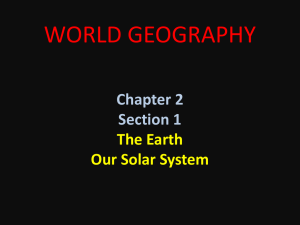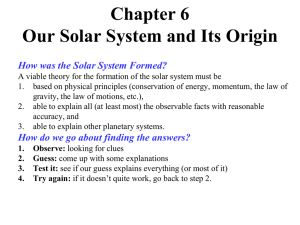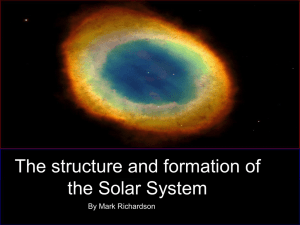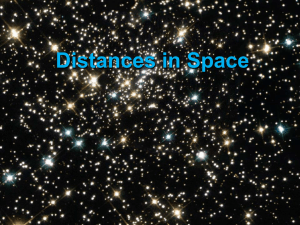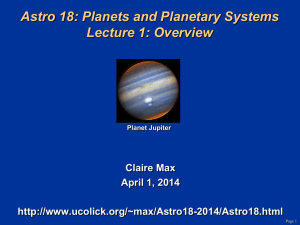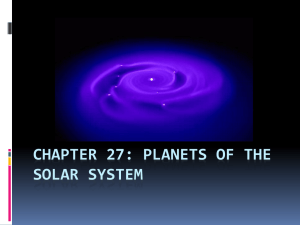Chapter 28 Review
advertisement
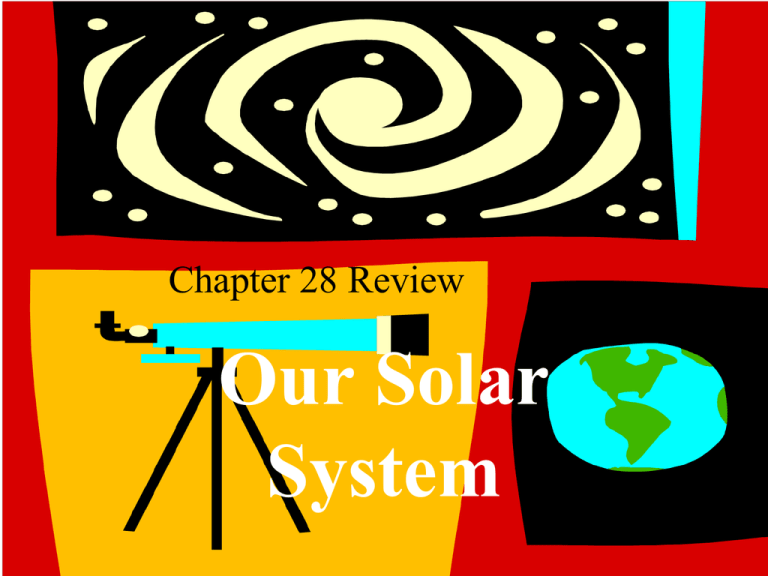
Chapter 28 Review Our Solar System What force draws the matter in an interstellar cloud together to form a star? A.electric B.gravity C.magnetism D.friction 0% A. 0% 0% B. C. 0% D. Which of the following correctly orders planets by decreasing day length? A. Venus, Earth, Jupiter B. Earth, Jupiter, Venus C. Jupiter, Earth, Venus D. Venus, Jupiter, Earth 0% A. 0% 0% B. C. 0% D. What is the main reason why Venus’ surface is so hot? 1. the large number of volcanoes on Venus 2. the very efficient greenhouse effect on Venus 3. the extremely fast rotation of Venus 4. the great amount of water on 0% 0% Venus 1 2 0% 3 0% 4 Which of the following is one of the characteristics an object MUST have to be classified as a dwarf planet by the IAU? 1. 2. 3. 4. a solid surface at least one moon a spherical shape a head and at least one tail 0% 1 0% 0% 2 3 0% 4 Which two planets are separated by a distance of 1.13 AU? 1. Mercury and Mars 2. Mars and Venus 3. Earth and Mercury 4. Mars and Earth 0% 1 0% 0% 2 3 0% 4 Use the data in the table to calculate the difference between the greatest and least density of the planets in the solar system. 1. 2. 3. 4. 4.83 g/cm3 5.17 g/cm3 6.21 g/cm3 5.83 g/cm3 0% 1 0% 0% 2 3 0% 4 Which correctly identifies the location of the asteroid belt? 1. 2. 3. 4. A B C D 0% 1 0% 0% 2 3 0% 4 At which labeled interval of its orbit would the planet move with the greatest velocity? 1. 2. 3. 4. A B C D 0% 1 0% 0% 2 3 0% 4 The center of mass for a typical planet in the solar system is shown by which point in the diagram? 1. 2. 3. 4. A B C D 0% 1 0% 0% 2 3 0% 4 Which of the following should be added to the column for Zone 2 in this table showing the three-zone classification system for objects in the solar system? 1. 2. 3. 4. Pluto Earth Eris Neptune 0% 1 0% 0% 2 3 0% 4 Bodies of interplanetary debris that orbit the Sun with most in the area between Mars and Jupiter are called 1. 2. 3. 4. meteors comets asteroids meteorites 0% 1 0% 0% 2 3 0% 4 Small, icy bodies that have highly eccentric orbits and can be found in the Oort cloud or the Kuiper belt are called 1. 2. 3. 4. meteors comets asteroids meteorites 0% 1 0% 0% 2 3 0% 4 Interplanetary material that enters the Earth's atmosphere and collides with the ground rather than burning up is called a(n) 1. 2. 3. 4. meteor comet asteroid meteorite 0% 1 0% 0% 2 3 0% 4 What two gas giants appear blue because of the methane in their atmosphere? 1. 2. 3. 4. Jupiter and Saturn Saturn and Uranus Neptune and Uranus Jupiter and Neptune 0% 1 0% 0% 2 3 0% 4 The result when Earth intersects a comet’s orbit is a(n) 1. asteroid shower 2. aurora borealis 3. loss of satellite communication 4. meteor shower 0% 1 0% 0% 2 3 0% 4 Can condense and become concentrated enough to form a star and possibly planets 1. Kepler’s second law 2. Law of universal gravitation 3. Interstellar cloud 4. Solar nebula 5. Retrograde motion 6. Planetismals 0% 1 0% 0% 0% 2 3 4 0% 0% 5 6 The movement of a planet in an opposing direction across the sky 1. Kepler’s second law 2. Law of universal gravitation 3. Interstellar cloud 4. Solar nebula 5. Retrograde motion 6. Planetismals 0% 1 0% 0% 0% 2 3 4 0% 0% 5 6 The disk of dust and gas that formed the Sun and planets 1. Kepler’s second law 2. Law of universal gravitation 3. Interstellar cloud 4. Solar nebula 5. Retrograde motion 6. Planetismals 0% 1 0% 0% 0% 2 3 4 0% 0% 5 6 Tiny grains of condensed material accumulate and merge together to form these large bodies that grow until they reach hundreds of kilometers in diameter 1. Kepler’s second law 2. Law of universal gravitation 3. Interstellar cloud 4. Solar nebula 5. Retrograde motion 6. Planetismals 0% 0% 0% 0% 1 2 3 4 0% 0% 5 6 An imaginary line between the Sun and a planet that sweeps out equal amounts of area in equal amounts of time 1. Kepler’s second law 2. Law of universal gravitation 3. Interstellar cloud 4. Solar nebula 5. Retrograde motion 6. Planetismals 0% 0% 0% 0% 0% 0% 1 2 3 4 5 6 The statement that describes the relationship among the masses of two bodies and the force and distance between them 1. Kepler’s second law 2. Law of universal gravitation 3. Interstellar cloud 4. Solar nebula 5. Retrograde motion 6. Planetismals 0% 0% 0% 0% 0% 0% 1 2 3 4 5 6 Earth’s average distance from the Sun: 1.496 108 km 1. 2. 3. 4. 5. 6. meteor interstellar cloud belt comet 1 astronomical unit precession 0% 1 0% 0% 0% 2 3 4 0% 0% 5 6 Cloud type that is low, warm, dark-colored, and sinking 1. 2. 3. 4. 5. 6. meteor interstellar cloud belt comet 1 astronomical unit precession 0% 0% 0% 0% 0% 0% 1 2 3 4 5 6 The wobble of Earth’s axis caused by the Moon’s gravitational force on Earth 1. meteor 2. interstellar cloud 3. belt 4. comet 5. 1 astronomical unit 6. precession 0% 0% 0% 0% 0% 0% 1 2 3 4 5 6 Cloud of gas and dust from which stars and planets are formed 1. meteor 2. interstellar cloud 3. belt 4. comet 5. 1 astronomical unit 6. precession 0% 0% 0% 0% 0% 0% 1 2 3 4 5 6 Interplanetary material that burns up and becomes a bright, glowing streak of light in Earth’s atmosphere 1. 2. 3. 4. 5. 6. meteor interstellar cloud belt comet 1 astronomical unit precession 0% 0% 0% 0% 0% 0% 1 2 3 4 5 6 Small, icy body made of ice and rock that has a highly eccentric orbit around the Sun 1. meteor 2. interstellar cloud 3. belt 4. comet 5. 1 astronomical unit 6. precession 0% 0% 0% 0% 0% 0% 1 2 3 4 5 6 Interstellar clouds are primarily composed of nitrogen and oxygen. 1. True 2. False 0% 1 0% 2 The force of gravity between two objects is determined entirely by their masses. 1. True 2. False 0% 1 0% 2 Mercury’s days and years are more similar in length than Earth’s days and years. 1. True 2. False 0% 1 0% 2 The difference between meteors and meteorites is their size. 1. True 2. False 0% 1 0% 2 The planets in part A of this diagram have more moons than the planets in part B. 1. True 2. False 0% 1 0% 2 Only one of the eight planets in the solar system has all three forms of water on its surface. 1. True 2. False 0% 1 0% 2 The inner planets have greater densities than the outer planets. 1. True 2. False 0% 1 0% 2 If the distance between these objects is doubled, the force of gravity between them will be halved. 1. True 2. False 0% 1 0% 2 Earth is the most tectonically active of the inner planets. 1. True 2. False 0% 1 0% 2 The shaded area of the graph shows the percentage of the total planetary matter in the solar system that is part of Earth’s mass. 1. True 2. False 0% 1 0% 2 All of the planets and their satellites orbit the Sun in the same direction, and all their orbits lie near the same plane. 1. True 2. False 0% 1 0% 2 Nicolaus Copernicus found that in a heliocentric model of the solar system, the inner planets move faster in their orbits than the outer planets, giving the appearance from Earth that some planets move in a retrograde motion. 1. True 2. False 0% 1 0% 2 Isaac Newton determined that each planet does not orbit the Sun but instead orbits a center of mass between it and the Sun. 1. True 2. False 0% 1 0% 2 Mars is the planet most similar to Earth in physical properties, such as diameter, mass, and density. 1. True 2. False 0% 1 0% 2 Mercury has the largest daynight temperature difference of all the planets in the solar system. 1. True 2. False 0% 1 0% 2 In the early 1500s, Tycho Brahe formulated the heliocentric model of the solar system. 1. True 2. False 0% 1 0% 2 Kepler’s first law demonstrates that each planet has an elliptical orbit of unique size and shape with the Sun at one focus. 1. True 2. False 0% 1 0% 2 Galileo’s discovery of Jupiter’s moons proved that not all celestial bodies orbit Earth; therefore, Earth is not necessarily the center of the solar system. 1. True 2. False 0% 1 0% 2 The high concentration of carbon dioxide (CO2) in the atmosphere of Mars inhibits infrared radiation from escaping and keeps the surface extremely hot. 1. True 2. False 0% 1 0% 2 Asteroids are thought to be leftover planetesimals that never formed planets from the time of the solar system’s formation. 1. True 2. False 0% 1 0% 2 The rapid rotation of Saturn distorts its shape so that the diameter through its equatorial plane is 7 percent larger than the diameter through its poles. 1. True 2. False 0% 1 0% 2 Neptune has clouds and atmospheric belts and zones similar to those of Saturn and Uranus. 1. True 2. False 0% 1 0% 2 The dense concentration of gas at the center of the solar nebula eventually became the Sun. 1. True 2. False 0% 1 0% 2 The Oort cloud and the Kuiper belt are asteroid belts. 1. True 2. False 0% 1 0% 2
